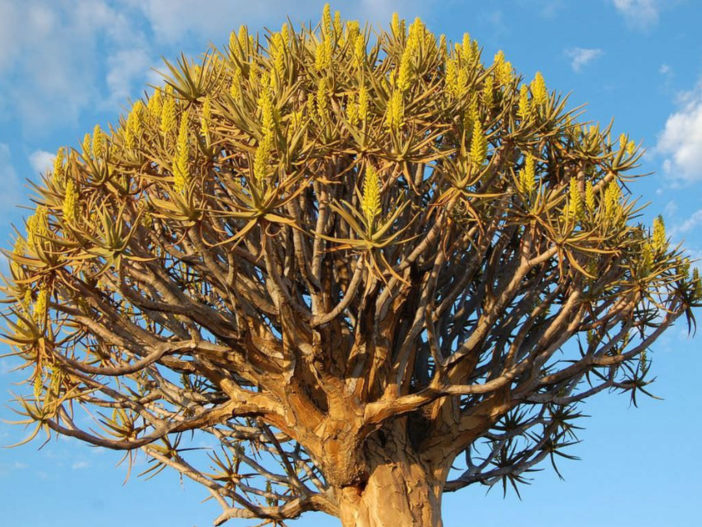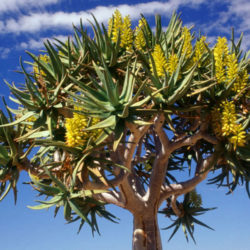Scientific Name
Aloidendron dichotomum (Masson) Klopper & Gideon F.Sm.
Common Name(s)
Kokerboom (Afrikaans), Quiver Tree
Synonym(s)
Aloe dichotoma, Rhipidodendrum dichotomum
Scientific Classification
Family: Asphodelaceae
Subfamily: Asphodeloideae
Genus: Aloe
Description
Aloidendron dichotomum, formerly known as Aloe dichotoma, is a distinctive succulent tree with a trunk and a densely rounded crown of smooth branches and blue-green leaves arranged in terminal rosettes. It may reach an age of over 80 years and a height of 23 feet (7 m). The branches are covered with a thin layer of whitish powder. They are repeatedly forked, hence the species name "dichotoma." The bark on the trunk forms beautiful golden-brown scales, but beware, the edges of these scales are razor-sharp. Leaves are ranked in vertical rows in juvenile plants.
The plant first blooms when it is about 20 to 30 years old. The bright yellow flowers appear in racemes at the top of the branches in winter.
Origin
The native range of Aloidendron dichotomum is from Nieuwoudtville in the Northern Cape province east to Olifantsfontein in the Gauteng Province of South Africa and northwards to the Brandberg in Namibia. It grows on slopes and sandy flats.

Hardiness
USDA hardiness zones 9a to 11b: from 20 °F (−6.7 °C) to 50 °F (+10 °C).
How to Grow and Care
Aloes are very forgiving plants. As with all succulents, Aloe must never be allowed to sit in stagnant water, and the plant should be carefully monitored to watch for signs of overwatering.
These succulents are not particularly fast-growing and will only rarely need repotting. In the spring, repot Aloes tipping over their pots or have ceased growing. Use a fast-draining potting mix with one-third of sand or pebbles. When repotting a larger plant, dividing the root ball carefully is possible. Some varieties of Aloe will send off offsets that can be potted independently.
Aloe plants need bright light. They can withstand full summer sun once acclimated. In the winter, provide bright light. It prefers warmer temperatures of 70 to 80 °F (21 to 27 °C) but will survive down to 40 °F (4.5 °C). Feed with a succulent fertilizer in the summer only. Suspend feeding in the winter as the plant goes dormant.
Learn more at How to Grow and Care for Aloe.
Links
- Back to genus Aloidendron
- Succupedia: Browse succulents by Scientific Name, Common Name, Genus, Family, USDA Hardiness Zone, Origin, or cacti by Genus
Photo Gallery
Click on a photo to see a larger version.



